TOYOTA COROLLA HATCHBACK 2020 Warranties & Maintenance Guides (in English)
Manufacturer: TOYOTA, Model Year: 2020, Model line: COROLLA HATCHBACK, Model: TOYOTA COROLLA HATCHBACK 2020Pages: 260, PDF Size: 8.54 MB
Page 131 of 260

MICHELIN
129
Exceeding the maximum speeds shown on the following page for each
type of MICHELIN® tire will cause the tire to build up excessive heat,
which can cause tire damage that could result in sudden tire failure
and rapid air loss. Failure to control a vehicle when one or more tires \
experience a rapid air loss can lead to an accident.
In any case, you should not exceed reasonable speeds as indicated by
the legal limits and driving conditions.
Speed Rating System
The speed rating of a tire indicates the
speed category (or range of v speeds)
at which the tire can carry a load under
specified service conditions. The speed
rating system used today was developed
in Europe in response to the need to
categorize tires into standardized speeds.
A letter from A to Z symbolizes a tire’s
certified speed rating, ranging from 5 km/
hr (3 mph) to above 300 km/ hr (186
mph). This rating system (see chart on
this page) describes the top speed for
which a tire is certified.
When this speed rating system was originally developed, the
Unlimited V category of over 210 km/hr (130 mph) was the top speed
rating a tire could achieve. As manufacturers made more tires that fit
into this category, it was necessary to better regulate performance at
standardized speeds to help ensure safety. The Limited V category of
240 km/hr (149 mph) was then created, and the Z or (Y) speed rating
was added as the top speed rating that a tire could achieve. W and Y
limited speed symbols have been added as higher speed categories.
Always consult the tire manufacturer for the maximum speed of
Page 132 of 260
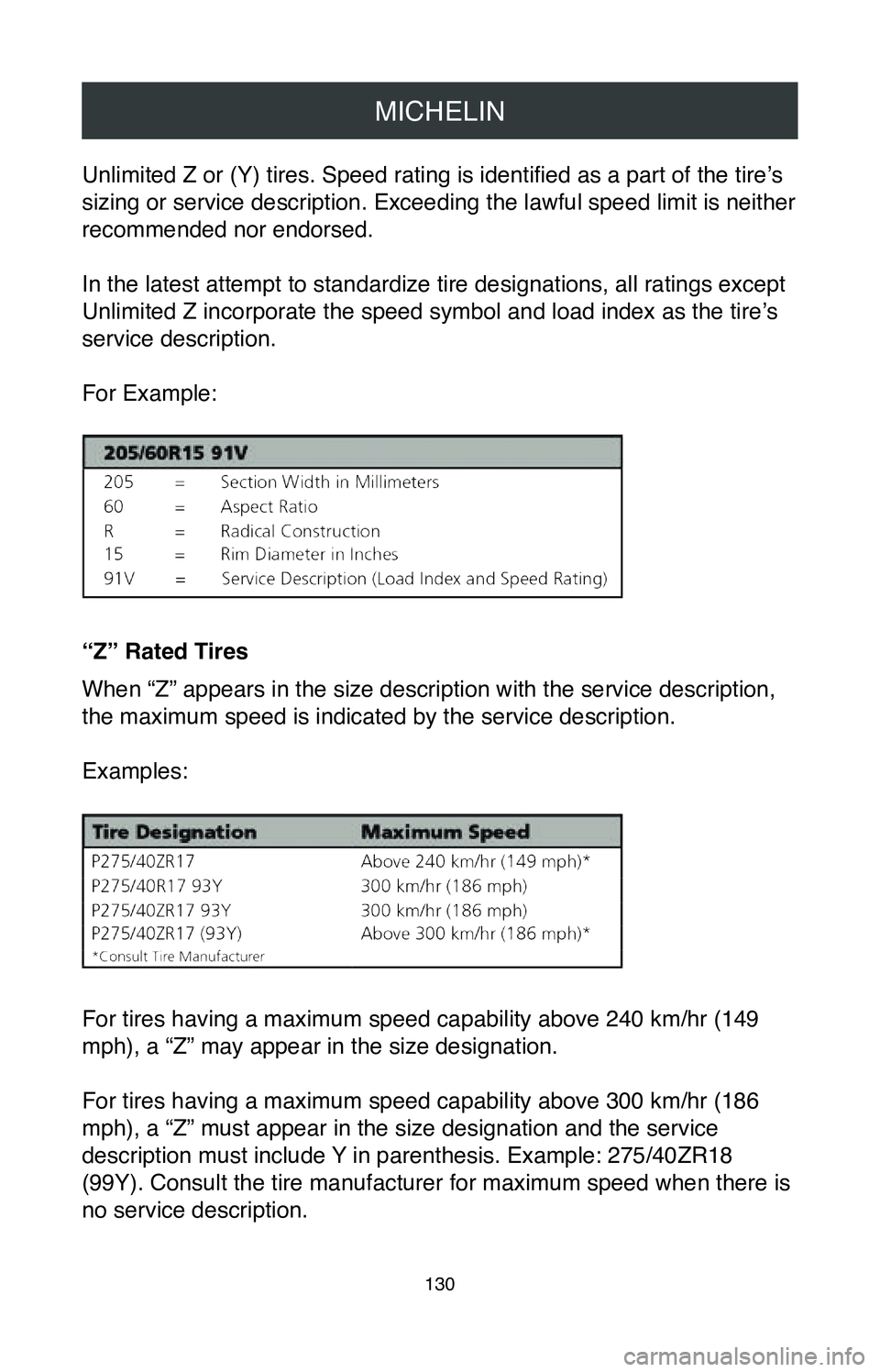
MICHELIN
130
Unlimited Z or (Y) tires. Speed rating is identified as a part of the tire’s
sizing or service description. Exceeding the lawful speed limit is neith\
er
recommended nor endorsed.
In the latest attempt to standardize tire designations, all ratings exce\
pt
Unlimited Z incorporate the speed symbol and load index as the tire’ s
service description.
For Example:
“Z” Rated Tires
When “Z” appears in the size description with the service descript\
ion,
the maximum speed is indicated by the service description.
Examples:
For tires having a maximum speed capability above 240 km/hr (149
mph), a “Z” may appear in the size designation.
For tires having a maximum speed capability above 300 km/hr (186
mph), a “Z” must appear in the size designation and the service
description must include Y in parenthesis. Example: 275/40ZR18
(99Y). Consult the tire manufacturer for maximum speed when there is
no service description.
Page 133 of 260
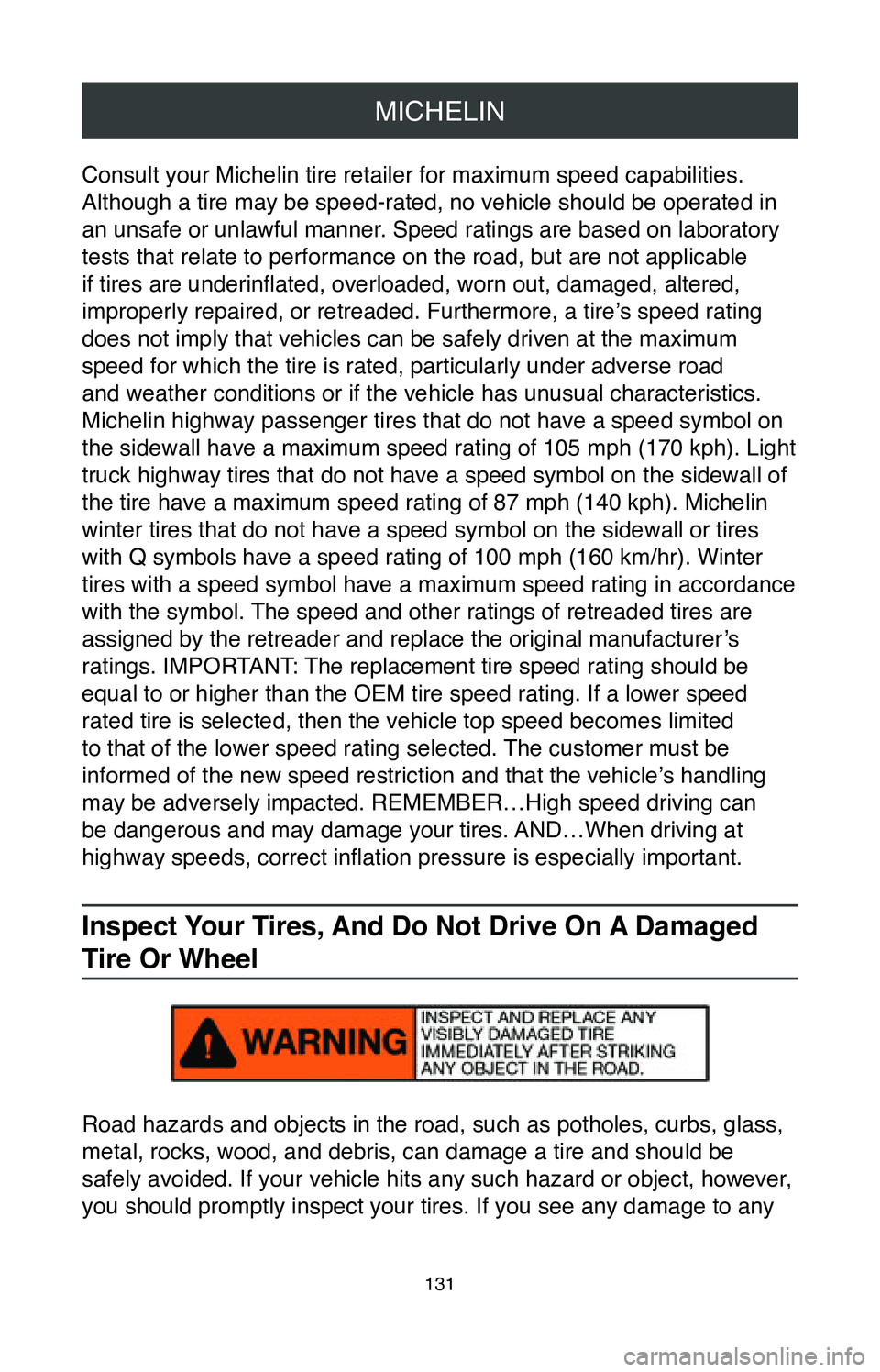
MICHELIN
131
Consult your Michelin tire retailer for maximum speed capabilities.
Although a tire may be speed-rated, no vehicle should be operated in
an unsafe or unlawful manner. Speed ratings are based on laboratory
tests that relate to performance on the road, but are not applicable
if tires are underinflated, overloaded, worn out, damaged, altered,
improperly repaired, or retreaded. Furthermore, a tire’s speed rating
does not imply that vehicles can be safely driven at the maximum
speed for which the tire is rated, particularly under adverse road
and weather conditions or if the vehicle has unusual characteristics.
Michelin highway passenger tires that do not have a speed symbol on
the sidewall have a maximum speed rating of 105 mph (170 kph). Light
truck highway tires that do not have a speed symbol on the sidewall of
the tire have a maximum speed rating of 87 mph (140 kph). Michelin
winter tires that do not have a speed symbol on the sidewall or tires
with Q symbols have a speed rating of 100 mph (160 km/hr). Winter
tires with a speed symbol have a maximum speed rating in accordance
with the symbol. The speed and other ratings of retreaded tires are
assigned by the retreader and replace the original manufacturer’s
ratings. IMPORTANT: The replacement tire speed rating should be
equal to or higher than the OEM tire speed rating. If a lower speed
rated tire is selected, then the vehicle top speed becomes limited
to that of the lower speed rating selected. The customer must be
informed of the new speed restriction and that the vehicle’s handling
may be adversely impacted. REMEMBER…High speed driving can
be dangerous and may damage your tires. AND…When driving at
highway speeds, correct inflation pressure is especially important.
Inspect Your Tires, And Do Not Drive On A Damaged
Tire Or Wheel
Road hazards and objects in the road, such as potholes, curbs, glass,
metal, rocks, wood, and debris, can damage a tire and should be
safely avoided. If your vehicle hits any such hazard or object, however,
you should promptly inspect your tires. If you see any damage to any
Page 134 of 260
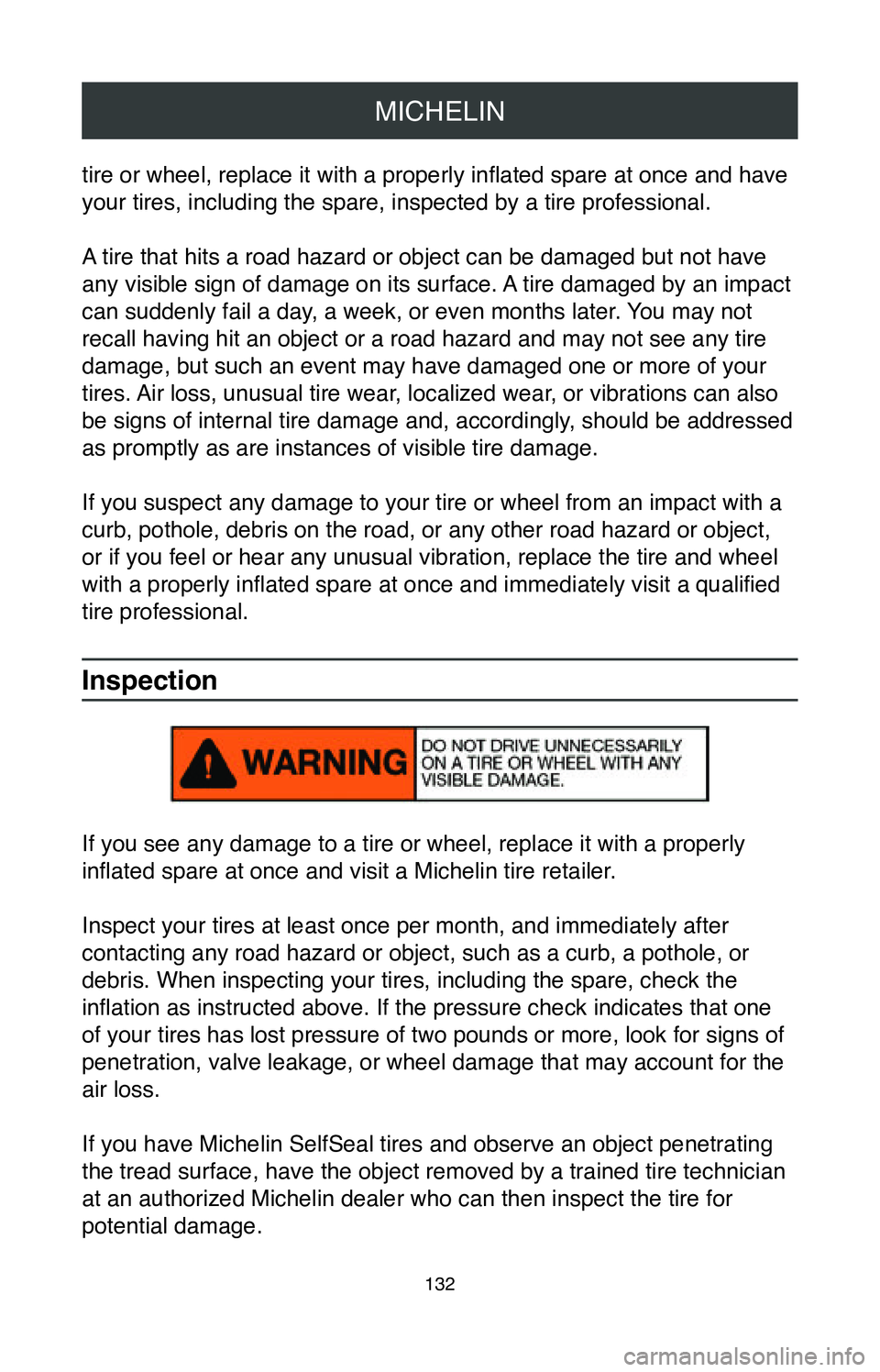
MICHELIN
132
tire or wheel, replace it with a properly inflated spare at once and have
your tires, including the spare, inspected by a tire professional.
A tire that hits a road hazard or object can be damaged but not have
any visible sign of damage on its surface. A tire damaged by an impact
can suddenly fail a day, a week, or even months later. You may not
recall having hit an object or a road hazard and may not see any tire
damage, but such an event may have damaged one or more of your
tires. Air loss, unusual tire wear, localized wear, or vibrations can also
be signs of internal tire damage and, accordingly, should be addressed
as promptly as are instances of visible tire damage.
If you suspect any damage to your tire or wheel from an impact with a
curb, pothole, debris on the road, or any other road hazard or object,
or if you feel or hear any unusual vibration, replace the tire and wheel\
with a properly inflated spare at once and immediately visit a qualified
tire professional.
Inspection
If you see any damage to a tire or wheel, replace it with a properly
inflated spare at once and visit a Michelin tire retailer.
Inspect your tires at least once per month, and immediately after
contacting any road hazard or object, such as a curb, a pothole, or
debris. When inspecting your tires, including the spare, check the
inflation as instructed above. If the pressure check indicates that one
of your tires has lost pressure of two pounds or more, look for signs of\
penetration, valve leakage, or wheel damage that may account for the
air loss.
If you have Michelin SelfSeal tires and observe an object penetrating
the tread surface, have the object removed by a trained tire technician
at an authorized Michelin dealer who can then inspect the tire for
potential damage.
Page 135 of 260
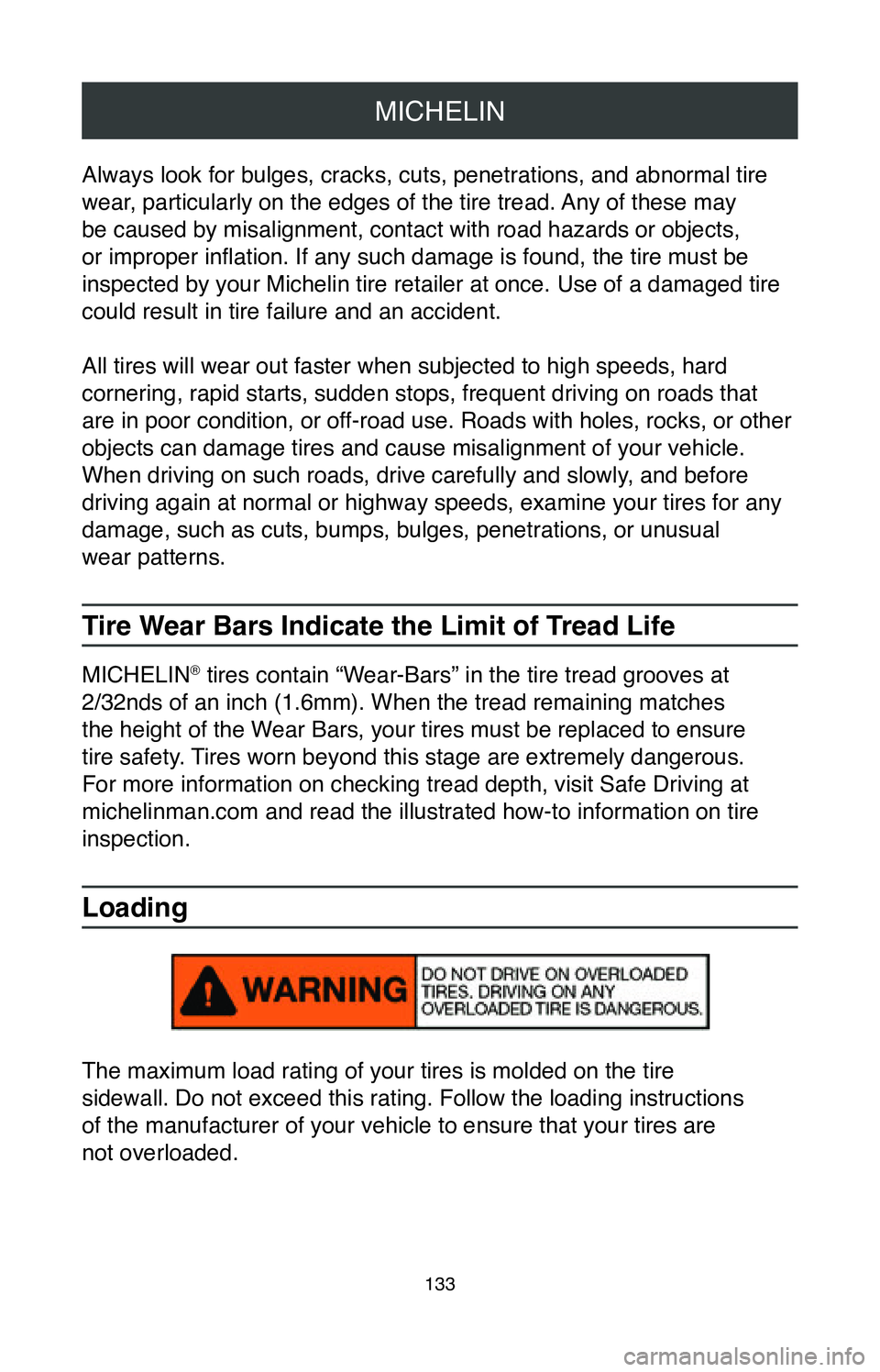
MICHELIN
133
Always look for bulges, cracks, cuts, penetrations, and abnormal tire
wear, particularly on the edges of the tire tread. Any of these may
be caused by misalignment, contact with road hazards or objects,
or improper inflation. If any such damage is found, the tire must be
inspected by your Michelin tire retailer at once. Use of a damaged tire \
could result in tire failure and an accident.
All tires will wear out faster when subjected to high speeds, hard
cornering, rapid starts, sudden stops, frequent driving on roads that
are in poor condition, or off-road use. Roads with holes, rocks, or other
objects can damage tires and cause misalignment of your vehicle.
When driving on such roads, drive carefully and slowly, and before
driving again at normal or highway speeds, examine your tires for any
damage, such as cuts, bumps, bulges, penetrations, or unusual
wear patterns.
Tire Wear Bars Indicate the Limit of Tread Life
MICHELIN® tires contain “Wear-Bars” in the tire tread grooves at
2/32nds of an inch (1.6mm). When the tread remaining matches
the height of the Wear Bars, your tires must be replaced to ensure
tire safety. Tires worn beyond this stage are extremely dangerous.
For more information on checking tread depth, visit Safe Driving at
michelinman.com and read the illustrated how-to information on tire
inspection.
Loading
The maximum load rating of your tires is molded on the tire
sidewall. Do not exceed this rating. Follow the loading instructions
of the manufacturer of your vehicle to ensure that your tires are
not overloaded.
Page 136 of 260

MICHELIN
134
Tires loaded beyond their maximum allowable loads for the particular
application will build up excessive heat that may result in sudden tire \
failure and an accident. Do not exceed the gross axle weight rating for \
any axle on your vehicle.
Trailer Towing
If you anticipate towing a trailer, you should visit your Michelin tire
retailer for advice about the correct tire size and pressures. Tire size
and pressures will depend on the type and size of trailer and hitch
utilized, but in no case must the maximum cold inflation pressure
or tire load rating be exceeded. Check the tire information placard
that came on your vehicle, (located in the vehicle’s door jamb, inside
the fuel hatch, or on the glove compartment door) and the owner’s
manual supplied by the manufacturer of your vehicle for further
recommendations on trailer towing.
Self-Supporting Zero Pressure (ZP) Tires and Trailer Towing
Operation of ZP tires at low or zero air pressure with a trailer in tow
is dangerous and should be avoided. If the low pressure warning
indicator is activated when a trailer is in tow, stop, disconnect the
trailer, and do not continue to tow the trailer until the tire has been
properly repaired and re-inflated to the proper inflation. If the tire
cannot be properly repaired, it must be replaced with a new full-size,
matching ZP tire, and inflated to the proper inflation, before the trailer
can be safely towed again.
Wheel Alignment and Balancing Are Important for
Safety and Maximum Mileage from Your Tires.
Page 137 of 260
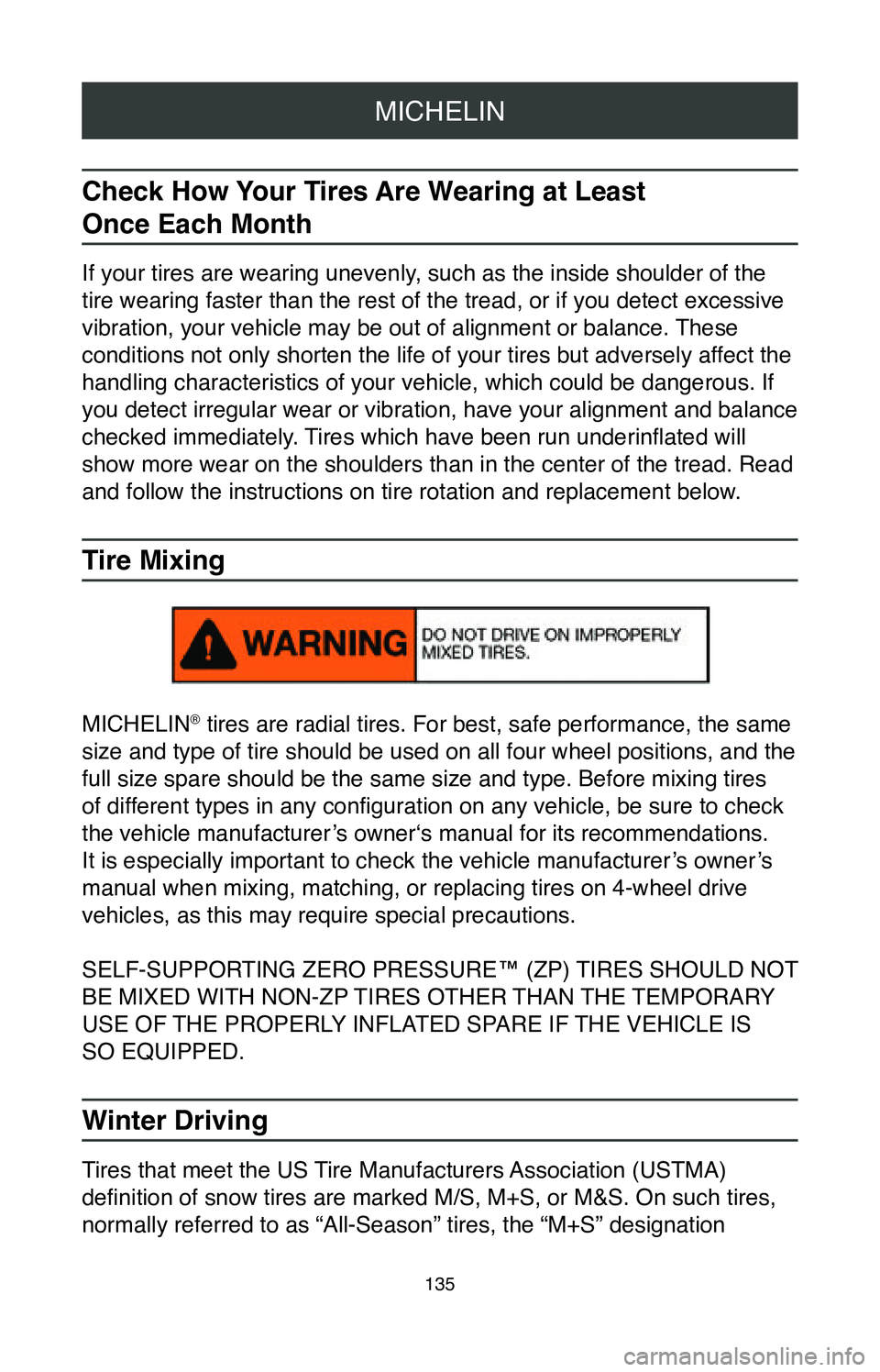
MICHELIN
135
Check How Your Tires Are Wearing at Least
Once Each Month
If your tires are wearing unevenly, such as the inside shoulder of the
tire wearing faster than the rest of the tread, or if you detect excessi\
ve
vibration, your vehicle may be out of alignment or balance. These
conditions not only shorten the life of your tires but adversely affect the
handling characteristics of your vehicle, which could be dangerous. If
you detect irregular wear or vibration, have your alignment and balance
checked immediately. Tires which have been run underinflated will
show more wear on the shoulders than in the center of the tread. Read
and follow the instructions on tire rotation and replacement below.
Tire Mixing
MICHELIN® tires are radial tires. For best, safe performance, the same
size and type of tire should be used on all four wheel positions, and th\
e
full size spare should be the same size and type. Before mixing tires
of different types in any configuration on any vehicle, be sure to check
the vehicle manufacturer’s owner‘s manual for its recommendations.
It is especially important to check the vehicle manufacturer’s owner’s
manual when mixing, matching, or replacing tires on 4-wheel drive
vehicles, as this may require special precautions.
SELF-SUPPORTING ZERO PRESSURE™ (ZP) TIRES SHOULD NOT
BE MIXED WITH NON-ZP TIRES OTHER THAN THE TEMPORARY
USE OF THE PROPERLY INFLATED SPARE IF THE VEHICLE IS
SO EQUIPPED.
Winter Driving
Tires that meet the US Tire Manufacturers Association (USTMA)
definition of snow tires are marked M/S, M+S, or M&S. On such tires,
normally referred to as “All-Season” tires, the “M+S” designation
Page 138 of 260
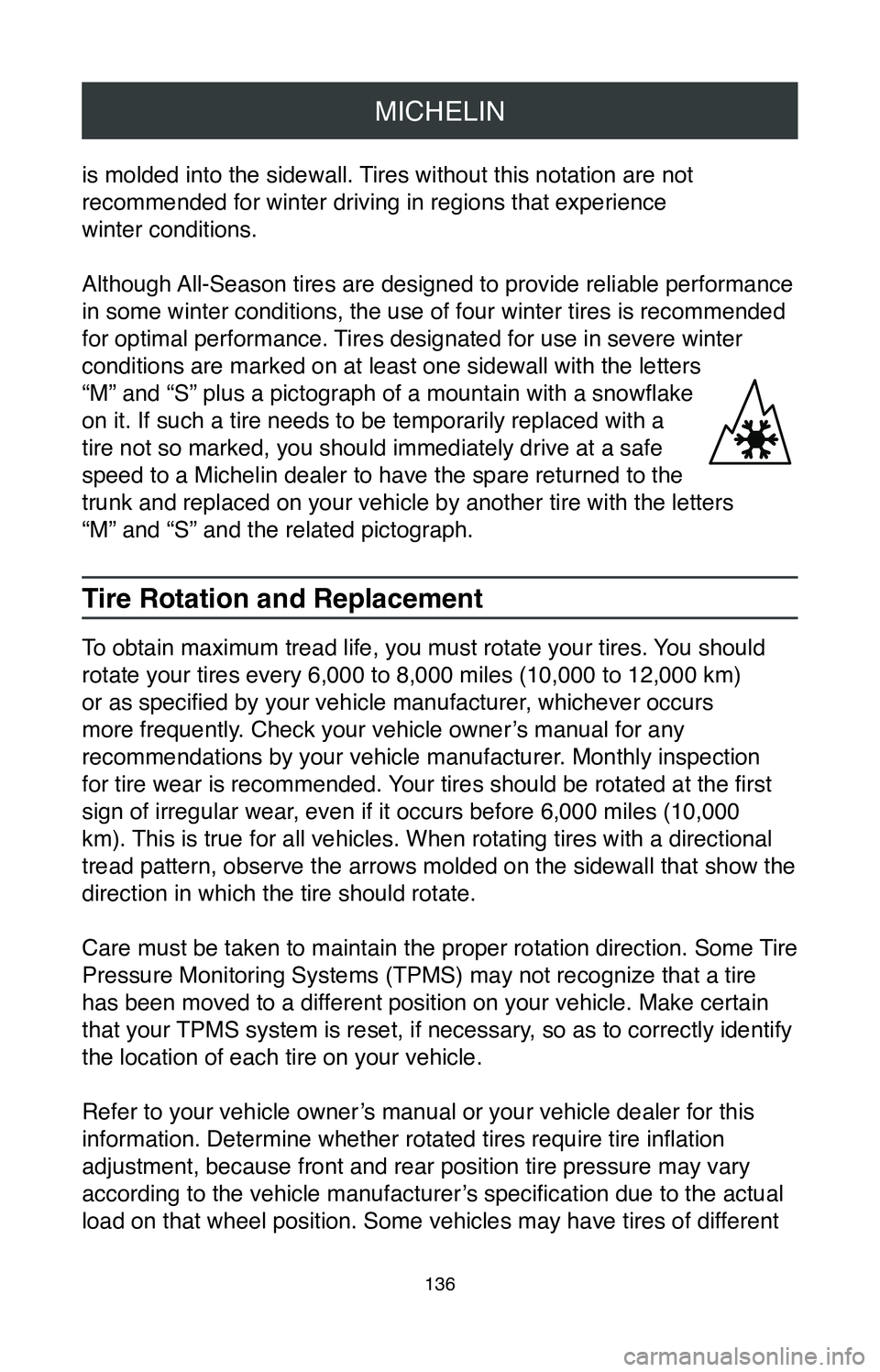
MICHELIN
136
is molded into the sidewall. Tires without this notation are not
recommended for winter driving in regions that experience
winter conditions.
Although All-Season tires are designed to provide reliable performance
in some winter conditions, the use of four winter tires is recommended
for optimal performance. Tires designated for use in severe winter
conditions are marked on at least one sidewall with the letters
“M” and “S” plus a pictograph of a mountain with a snowflake
on it. If such a tire needs to be temporarily replaced with a
tire not so marked, you should immediately drive at a safe
speed to a Michelin dealer to have the spare returned to the
trunk and replaced on your vehicle by another tire with the letters
“M” and “S” and the related pictograph.
Tire Rotation and Replacement
To obtain maximum tread life, you must rotate your tires. You should
rotate your tires every 6,000 to 8,000 miles (10,000 to 12,000 km)
or as specified by your vehicle manufacturer, whichever occurs
more frequently. Check your vehicle owner’s manual for any
recommendations by your vehicle manufacturer. Monthly inspection
for tire wear is recommended. Your tires should be rotated at the first
sign of irregular wear, even if it occurs before 6,000 miles (10,000
km). This is true for all vehicles. When rotating tires with a directional
tread pattern, observe the arrows molded on the sidewall that show the
direction in which the tire should rotate.
Care must be taken to maintain the proper rotation direction. Some Tire
Pressure Monitoring Systems (TPMS) may not recognize that a tire
has been moved to a different position on your vehicle. Make certain
that your TPMS system is reset, if necessary, so as to correctly identify
the location of each tire on your vehicle.
Refer to your vehicle owner’s manual or your vehicle dealer for this
information. Determine whether rotated tires require tire inflation
adjustment, because front and rear position tire pressure may vary
according to the vehicle manufacturer’s specification due to the actual
load on that wheel position. Some vehicles may have tires of different
Page 139 of 260
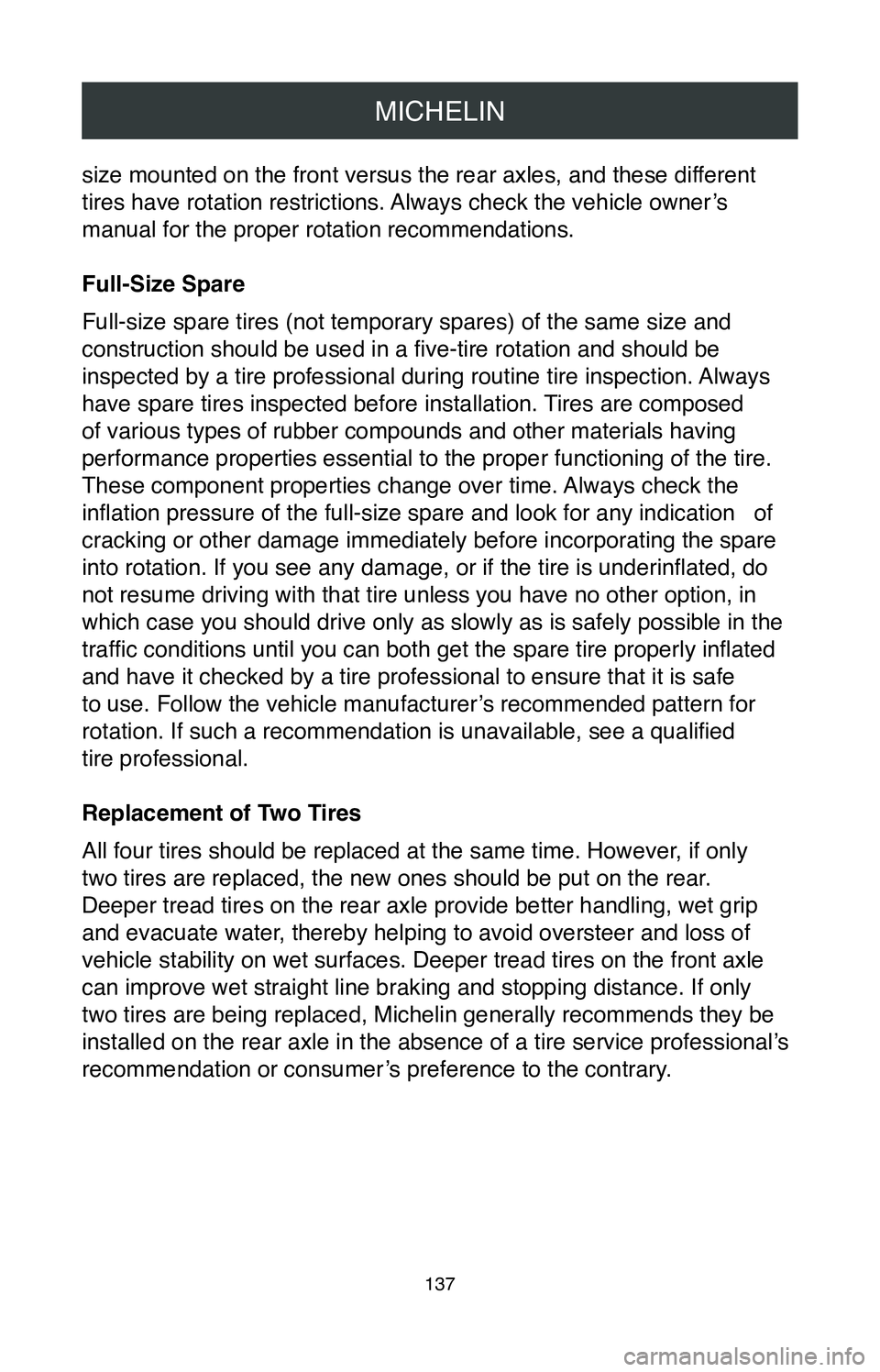
MICHELIN
137
size mounted on the front versus the rear axles, and these different
tires have rotation restrictions. Always check the vehicle owner’s
manual for the proper rotation recommendations.
Full-Size Spare
Full-size spare tires (not temporary spares) of the same size and
construction should be used in a five-tire rotation and should be
inspected by a tire professional during routine tire inspection. Always
have spare tires inspected before installation. Tires are composed
of various types of rubber compounds and other materials having
performance properties essential to the proper functioning of the tire. \
These component properties change over time. Always check the
inflation pressure of the full-size spare and look for any indication of
cracking or other damage immediately before incorporating the spare
into rotation. If you see any damage, or if the tire is underinflated, do
not resume driving with that tire unless you have no other option, in
which case you should drive only as slowly as is safely possible in the \
traffic conditions until you can both get the spare tire properly inflated
and have it checked by a tire professional to ensure that it is safe
to use. Follow the vehicle manufacturer’s recommended pattern for
rotation. If such a recommendation is unavailable, see a qualified
tire professional.
Replacement of Two Tires
All four tires should be replaced at the same time. However, if only
two tires are replaced, the new ones should be put on the rear.
Deeper tread tires on the rear axle provide better handling, wet grip
and evacuate water, thereby helping to avoid oversteer and loss of
vehicle stability on wet surfaces. Deeper tread tires on the front axle \
can improve wet straight line braking and stopping distance. If only
two tires are being replaced, Michelin generally recommends they be
installed on the rear axle in the absence of a tire service professional’ s
recommendation or consumer’s preference to the contrary.
Page 140 of 260

MICHELIN
138
Customization of Tires, Wheels, or Suspension on
SUVs and Light Trucks
Due to their size, weight and higher center of gravity, vehicles such as
SUVs and light trucks do not have the same handling characteristics
as automobiles. Because of these different characteristics, failure to
operate your SUV or truck in a proper and safe manner can increase
the likelihood of vehicle rollover. Modifications to your SUV or truck
tire size, tire type, wheels or suspension can change your vehicle’s
handling characteristics and further increase the likelihood of vehicle \
rollover. Whether your SUV or truck has the original equipment
configuration for tires, wheels and suspension or whether any of these
items have been modified, always drive safely, avoid sudden, sharp
turns or lane changes and obey all traffic laws. Failure to do so may
result in loss of vehicle control leading to an accident and serious injury
or death.
Tire Alterations
Do not make or allow to be made any alterations on your tires.
Alterations may prevent proper performance, leading to tire damage
that can result in an accident. Tires that become unserviceable due
to alterations such as truing, whitewall inlays, addition of balancing
or sealant liquids, or the use of tire dressing containing petroleum
distillates, are excluded from warranty coverage.
Tire Repairs